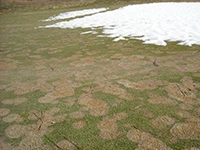
Rob Golembiewski, Ph.D., is part of the Bayer Green Solutions Team
The Problem: Pink and gray snow molds are devastating turf diseases that occur on golf course putting greens, tees, and fairways in the presence of snow cover. These diseases are not only unsightly in the spring but can leave the turf surfaces unplayable. Both pink and gray snow molds can affect all cool-season turfgrasses, but tend to be more problematic on annual bluegrass and bentgrasses.
 |
What to Look for: Pink snow mold, caused by Microdochium nivale, occurs in cold (32-50 degrees F), wet weather with intermittent periods of snow cover (less than 60 days). Symptoms are visible at snow melt as tan patches 2-12 inches in diameter with a pink border. The affected areas change in color to a whitish gray with leaves taking on a bleached appearance. Individual patches may coalesce, resulting in extensive damage to the turf.
Solutions: Implementing proper cultural practices will assist in reducing disease severity. Management strategies include: avoiding late fall fertilization that leads to lush growth, controlling excessive thatch, removing tree leaves from the turf, managing drifting snow, and removing snow/improving drainage to promote rapid drying in the early spring.
 |
A pre-snow preventive application is critical for protecting vulnerable turf areas from snow mold. While disease symptoms develop under snow cover, sclerotia begin to germinate in the fall at 50-65 degrees F. An additional application during this time period has been shown to reduce disease severity the following spring. After your last mowing of the season but prior to snow cover, a final fungicide application is needed. Products or mixtures containing 2-3 different active ingredients have been shown to provide exceptional snow mold control.
As with any snow mold fungicides, if treated areas are subject to abnormal weather, heavy rainfall or snowfall that melts prior to permanent snow cover, a repeat application may be necessary to provide adequate snow mold protection.
Get curated news on YOUR industry.
Enter your email to receive our newsletters.Latest from Golf Course Industry
- Singapore Island CC reopens Island Course after renovation
- Pinnacle Golf managing Revival GC at the Crescent
- GCSAA honors duo for advocacy efforts
- Quickly back into play
- Audubon International names BioBlitz winners
- Eaglebrooke reopening after six-month renovation
- Sipcam Agro USA hires new national sales manager
- Reel Turf Techs: Andrzej Strzepek






